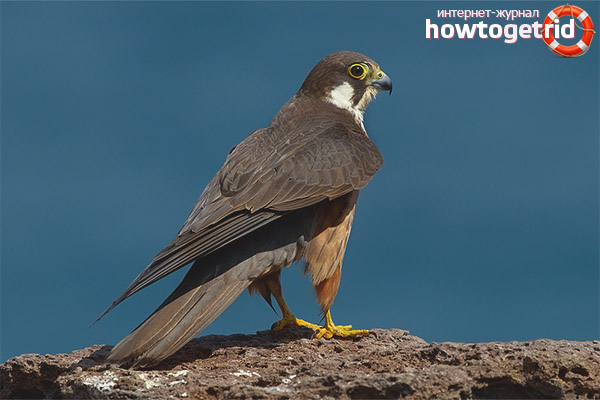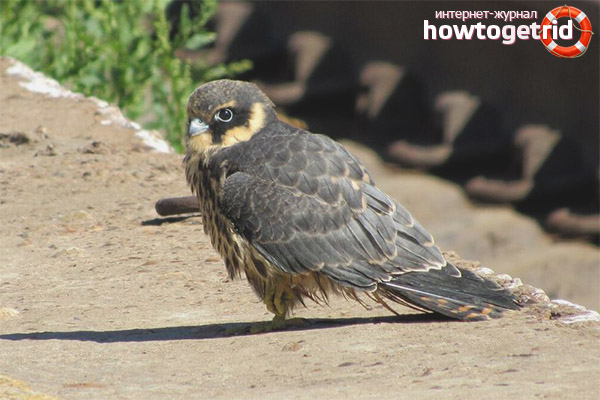The content of the article
Cheglok is a bird of prey, but its size is much smaller than other falconry representatives. Due to its small size it rises very quickly and easily into the air, performs various maneuvers.
Description of the appearance of the cheglock bird
If you compare with other birds of the falcon family, it is in many ways similar to them, and its main difference is its size. But this does not prevent him from being a brave hunter like his larger relatives.
It may seem that the appearance of the bird is very similar to the "peregrine Falcon", but this is only at the initial glance. They differ in their size - the cheglok is smaller, its lower body is covered with longitudinal spots and is dressed in red-red “panties”.
In an adult bird, the body length can be up to 36 cm. Externally, the wings are small, but with a wingspan of 80-84 cm. A cheglock weighs from 150 to 350 grams. The male is distinguished from the female in size, but it is not easy to recognize them, since the female is only slightly larger.
The color of the bird is bright and colorful, it consists of black, white, gray and cinnamon. But they are so contrasted and harmonious that they immediately attract attention. Females and males have the same dark, grayish upper body. Below, the bird has an ocher-colored plumage covered with black speckles. The neck and cheeks are white, there are mustaches near the beak, they are black and give the bird a more intimidating appearance.
“Panties” and underwrap of the bird are dark brown. The paws stand out well and are immediately noticeable, since they have a green or blue hue.
The tail and legs have brown plumage. The limbs are strong and strong, the claws are bent, sharp. The tail resembles a blade in shape, and the wings are sickle-shaped. The flight of the bird cheglock is very fast, can be intermittent. If a predator has caught a stream of air, then in this position it can fly for a long time, while not making any movements.
Where does the cheglock live?
Such a bird can be found on almost every continent, where there are suitable conditions for it. It can be Russia, Finland, Vietnam, the British and Japanese islands, Tunisia, Morocco. With the advent of cold weather, birds migrate towards South Africa, India and Southeast Asia.
Within Europe, the bird is not constantly located, for about six months, after which it moves to another place for nesting.
Habitat bird cheglock
For life, the feathered one chooses forests and forest-steppes - an area where there are many thickets and an open area. Shrubs on the banks of forest rivers, open plain and field landscapes are best suited for them. There have been cases when this bird settled close to people, but this happens quite rarely, usually it avoids contact with humans.
He loves height and feels comfortable at high altitudes up to 4000 meters, especially if it is above the sea.
The bird is flat and not adapted to a settled way of life. Every year she searches for herself a better place and a favorable living environment. This is due to the fact that it is completely unsuitable for low air temperature, cold and frost. In the warm season, it inhabits Northern Eurasia, and breeding and breeding take place there.
It is very rare that it can make a nest in the depths of a forest area with a mosaic structure, that is, it is forests, fields, a patch, a fringe. Located in the southern region, birds settle in dense thickets and steppes.
If danger is approaching, then the nest is guarded by both parents. As soon as the enemy approaches, the birds attack him first to drive them away from their home with the chicks.In the event that a person is trying to get to the nest, they can also attack, or imitate the attack and at that moment make loud, piercing sounds.
Bird lifestyle and character
The character of the bird is the restless and restless. They are not friendly, they are always aggressive towards other species of birds. This is not to say that this is due to a lack of food or something else, they just maliciously begin to behave when another bird appears. And if this individual also tries to approach the nest - then there will definitely be a fight. A black mustache and a formidable gaze to the cheglock give rigor and an awesome look.
If a bird smaller than a cheglock appeared in sight, then for him it already becomes prey, and he tries to catch it. Not every time it turns out, but any other feathered is already a target for him.
We can say that for humans, the cheglok is a useful bird, because if it nests close to its house and garden, it will relieve other birds that can harm trees and plants.
Food
This bird flies away for hunting alone, living species in the neighborhood, not far from its nest, become its prey. The bird usually chooses the time for food in the evening, when it is just beginning to get dark. In the summer, if the moon is full and the terrain is well lit, hunting can continue.
The diet is quite diverse, most of all hunting is for insects. Dragonflies and bats, beetles, locusts, small rodents, such as swifts and starling can also be tasty prey.
This bird prefers most of all to village and coastal swallows. Due to its excellent vision, prey is caught during the flight. Sometimes prey, which is caught in the air, is not enough, and you have to catch rodents. This is much more difficult than fishing in the air. Catching a large prey, the falcon will eat it right away on the nearest tree, and if something small comes across, it will swallow on the fly.
Cheglok is able to see small prey for 250 meters, and if it is a bird, then at a distance of a kilometer. A bird can easily take prey from another predator. Having caught in the air, he holds it with his powerful paws and digs his sharp claws, sits down on a tree and begins to eat.
Reproduction and longevity
As soon as the first heat begins, in the early spring, the birds prepare for the breeding season. Males choose females during the flight to a warm country or when they arrive at a new place. Such birds create their pair, and remain with the selected female until the end.
If we talk about mating games, then, like many birds, the males behave differently, as usual, they begin to perform various maneuvers in the air. This period falls at the end of spring.
Trees for nests choose tall. The female is engaged in hatching eggs. This process lasts 27-31 days, then chicks appear. They have black eyes, the whole body is covered with a snow-white fluff, a bright yellow beak adorns the muzzle. Dad gets food, and mom feeds the children. Feeding young falcons can last up to two months. Until the time of migration comes, they remain all together.
Elegon's Cheglock is a related species of the feathered. Its size is larger than the chyglock bird and its character is much friendlier. Some birds have plumage of black color, other colors are not mixed.
Wildlife Cheglok has a lifespan of approximately 38 years.
Interesting Facts
- A bird is capable of making various sounds, both pleasant for hearing and loud, pressing on hearing - when danger approaches its nest.
- "Cheglok" is a name that came from Ancient Russia, and is translated as "authentic and true." Scientists think that it attaches this bird to other falcons, although it is smaller in size.
- The approximate number of chegloks is 3 mil; today it is stable. Human activity does not harm their lives, and there are almost no enemies among the natural environment.
- Such a bird is useful for nature, it destroys insects and protects trees from them.
- During the season, the bird lays up to four eggs; they do not have more than one clutch.
- These birds can use the same nest for a long time.
- The cheglock is not suitable for falconry; it does not prey on large birds.
- If you hear the cry of swallows, then you can see in the sky how the cheglok will attack them.
Video: cheglok (Falco subbuteo)













Submit